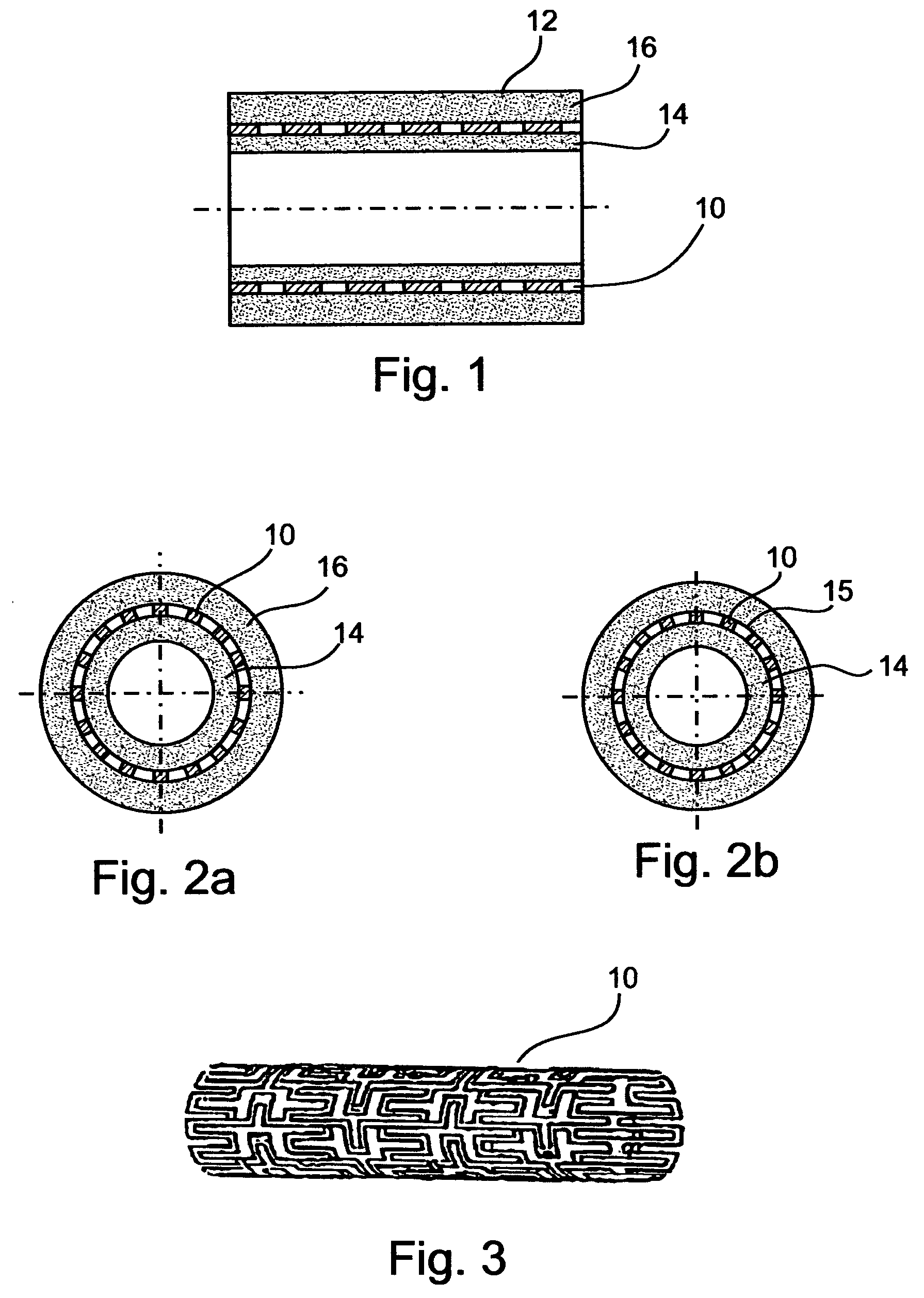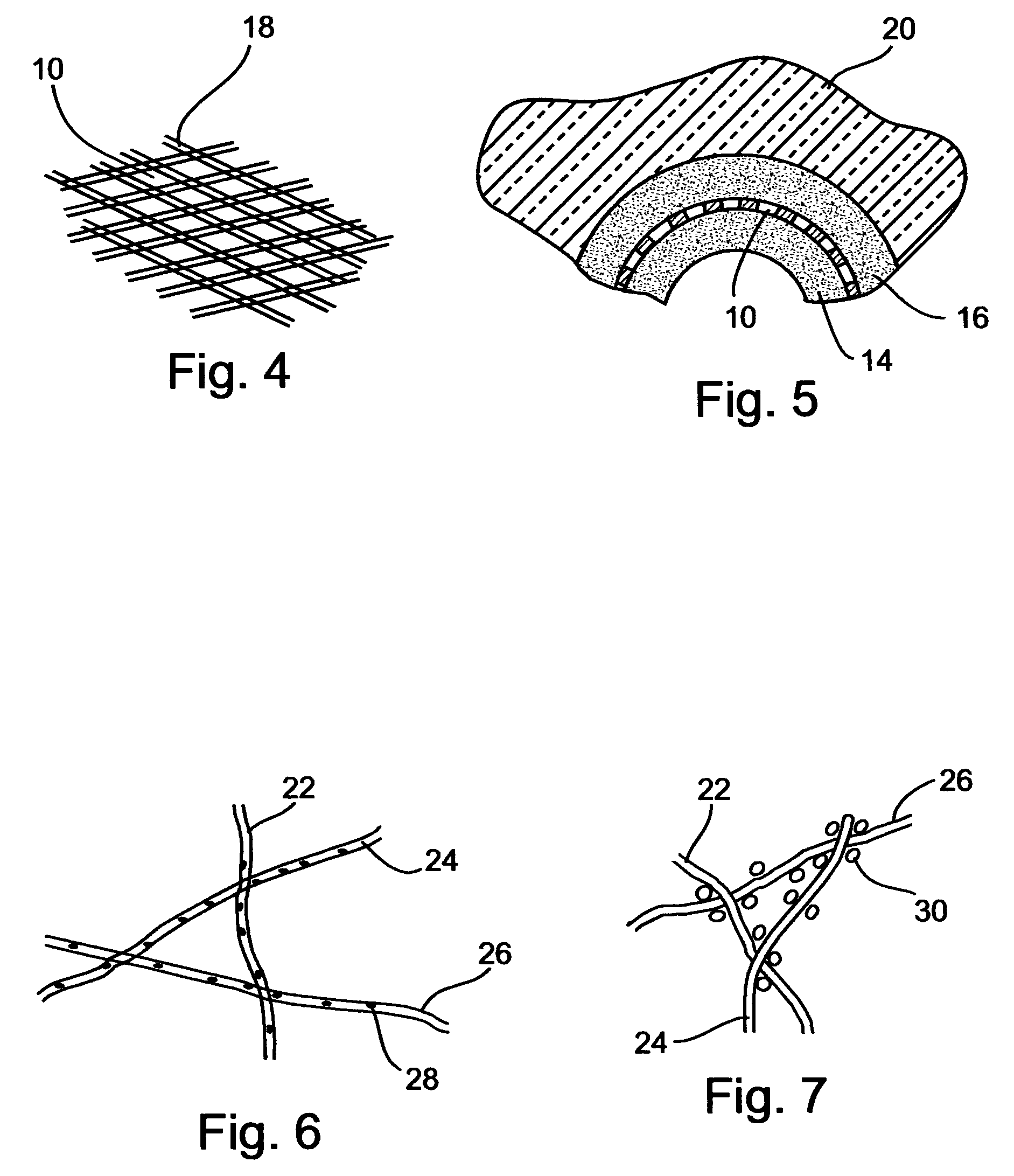Medicated polymer-coated stent assembly
- Summary
- Abstract
- Description
- Claims
- Application Information
AI Technical Summary
Problems solved by technology
Method used
Image
Examples
example 1
[0147] A stent assembly, 16 mm in length was manufactured using a stainless-steel stent, 3 mm in diameter in its expanded state, 1.9 mm in diameter in its non-expanded state, as the tubular supporting element. The used stainless-steel stent is typically intended for catheter and balloon angioplasty. For adhesion upgrading in polymer coating, the stent was exposed to 160-180 kJ / m.sup.2 corona discharge, rinsed by ethyl alcohol and deionized water, and dried in a nitrogen flow. The concentration of the solution was 8%; the viscosity was 560 cP; and the conductivity 0.8 .mu.S. For the pharmaceutical agent, heparin in tetrahydrofurane solution was used, at a concentration of 250 U / ml. The polymer to heparin-solution ratio was 100:1. A metal rod, 1.8 mm in diameter and 100 mm in length was used as a mandrel.
[0148] To ensure uniform, high-quality coating of an electrode having a low curvature radius, a planar subsidiary electrode was positioned near the mandrel, at a 40 mm distance from t...
example 2
[0151] A stent assembly was manufactured as described in Example 1, however the pharmaceutical agent was a heparin solution at a concentration of 380 U / ml mixed with 15% poly (DL-Lactide-CD-Glycolide) solution in chloroform.
[0152] In addition, for the dispensing electrode, two simultaneously operating spinnerets were used, mounted one above the other with a height difference of 20 mm therebetween. The first operable to dispense polyurethane while the second operable to dispense the biodegradable polymer poly (L-lactic acid). To ensure desirable correlation between the fiber volumes of polyurethane and the biodegradable polymer, the solution feeding were 0.1 ml / min for the first spinneret and 0.03 ml / min for the second spinneret.
example 3
[0153] A stent assembly was manufactured from the materials described in Example 1.
[0154] A two step coating process was employed. First, the mandrel was coated by electrospinning with polymer fiber layer the thickness of which was about 60 .mu.m. Once the first step was accomplished, the tubular supporting element was put over the first coat, hence an inner coating for the tubular supporting element was obtained. Before providing the outer coat, a subsidiary electrode, manufactured as a ring 120 mm in diameter, was mounted 16 mm behind the mandrel.
[0155] The subsidiary electrode was made of a wire 1 mm in thickness. The plane engaged by the subsidiary electrode was perpendicular to the mandrel's longitudinal axis. As in Example 1, the subsidiary electrode potential and the mandrel potential were substantially equal, however, unlike Example 1, the subsidiary electrode was kinematically connected to the spinneret, so as to allow synchronized motion of the two.
[0156] The second coat w...
PUM
| Property | Measurement | Unit |
|---|---|---|
| Dielectric polarization enthalpy | aaaaa | aaaaa |
| Structure | aaaaa | aaaaa |
| Adhesion strength | aaaaa | aaaaa |
Abstract
Description
Claims
Application Information
 Login to View More
Login to View More - R&D
- Intellectual Property
- Life Sciences
- Materials
- Tech Scout
- Unparalleled Data Quality
- Higher Quality Content
- 60% Fewer Hallucinations
Browse by: Latest US Patents, China's latest patents, Technical Efficacy Thesaurus, Application Domain, Technology Topic, Popular Technical Reports.
© 2025 PatSnap. All rights reserved.Legal|Privacy policy|Modern Slavery Act Transparency Statement|Sitemap|About US| Contact US: help@patsnap.com



